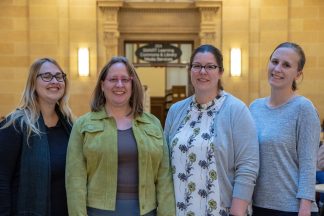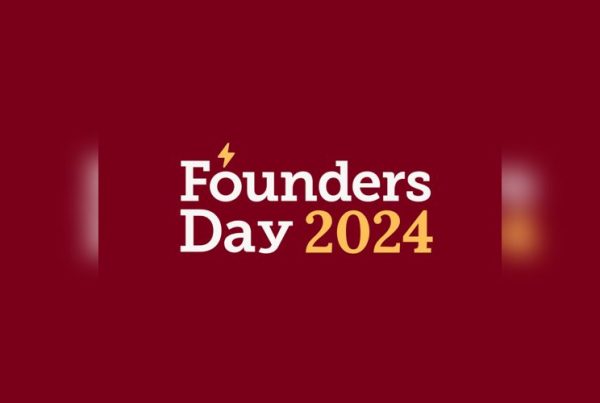By Kat Gerwig, Karen Carmody-McIntosh, Carolyn Bishoff, and Tiffany Reichard

Librarians Shannon Farrell and Meghan Lafferty with CSP Managing Director Laura Seifert, and grad student Ingrid Haugan
Every day, teams of scientists gather massive amounts of new information as they pursue their research. By sharing data with other researchers, a scientist can help increase the speed and decrease the cost of advancing knowledge.
But before researchers can share their data, they need to have a plan in place. The data need to be organized so they make sense to other researchers. Data also need to be saved in accessible file formats and distributed on platforms that other researchers can access.
Sharing complete data sets with other researchers is still a relatively new practice, but it’s quickly becoming a new standard. In the past, researchers shared their results within the journal articles they published, but there was no widespread call to publish the raw data they had gathered. Increasingly though, funding requirements include rules about data sharing and reuse.
When it comes to interpreting those requirements, the University Libraries can serve as a campus resource. Librarians and researchers can work together to set up procedures that support data sharing.
Case study: Center for Sustainable Polymers
It all started when the Center for Sustainable Polymers’ (CSP) reached out to the Libraries to improve their data sharing practices. They needed help bringing their procedures in line with data sharing recommendations from their primary funder, the National Science Foundation.
Original data files for scientific articles are not usually published with the paper. Librarians Meghan Lafferty, Shannon Farrell, and Carolyn Bishoff worked with a small group of CSP authors to change that. The librarians met with the authors to organize their data files. The original data for three scientific articles were then curated and published in the Data Repository for the University of Minnesota’s (DRUM).
“[The librarians’] expertise helped us to understand what was possible, while balancing the team’s priorities,” says Laura Seifert, Managing Director of the Center.
Seifert and the librarians designed and tested a workflow that any CSP scientist can use to publish their data in DRUM. Every article from the Center will be linked to a data set in the DRUM CSP data collection or another public data repository.
“At the very start there was some resistance to this initiative, because not everyone agreed there was a problem to solve. Now, the project has strong support from our researchers and faculty, and they recognize the potential benefits from the process we developed.”
CSP is leading the way
Word gets around! Ingrid Haugan is a grad student and one of the original CSP authors to use the new data sharing practices. She heard from a colleague at the University of Chicago that the CSP project was being highlighted as an example of good science because all the data was available to readers of the paper.
“I think that putting all of the primary data files in a data repository will help the CSP stand out, and I think that more centers and academic departments will likely move in that direction,” said Haugan.
The CSP is an NSF Center for Chemical Innovation. Their team is transforming the making and unmaking of plastics in a way that fosters environmental stewardship. In the wake of this project, departments at other institutions are looking at the improved CSP data practices as a way forward.
Seifert appreciates the thoughtful approach taken by U of M librarians, “Since the process was designed with consideration for the limited time researchers have, I am optimistic that it will become a practice that is adopted widely within and beyond the CSP.”




